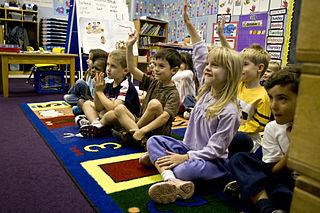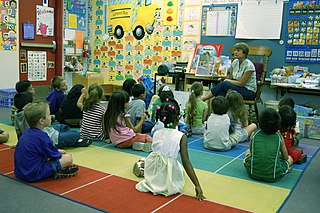
Kindergarten is a preschool educational approach based on playing, singing, practical activities such as drawing, and social interaction as part of the transition from home to school. Such institutions were originally made in the late 18th century in Germany, Bavaria and Alsace to serve children whose parents both worked outside home. The term was coined by German pedagogue Friedrich Fröbel, whose approach globally influenced early-years education. Today, the term is used in many countries to describe a variety of educational institutions and learning spaces for children ranging from two to six years of age, based on a variety of teaching methods.

Head Start is a program of the United States Department of Health and Human Services that provides comprehensive early childhood education, health, nutrition, and parent involvement services to low-income children and families. It is the oldest and largest program of its kind. The program's services and resources are designed to foster stable family relationships, enhance children's physical and emotional well-being, and establish an environment to develop strong cognitive skills. The transition from preschool to elementary school imposes diverse developmental challenges that include requiring the children to engage successfully with their peers outside the family network, adjust to the space of a classroom, and meet the expectations the school setting provides.

Childcare, also known as day care, is the care and supervision of one or more children, typically ranging from two weeks to 18 years old. Although most parents spend a significant amount of time caring for their child(ren), childcare typically refers to the care provided by caregivers who are not the child's parents. Childcare is a broad topic that covers a wide spectrum of professionals, institutions, contexts, activities, and social and cultural conventions. Early childcare is an important and often overlooked component of child development.

A preschool, also known as nursery school, pre-primary school, play school or creche, is an educational establishment or learning space offering early childhood education to children before they begin compulsory education at primary school. It may be publicly or privately operated, and may be subsidized from public funds. The typical age range for preschool in most countries is from 2 to 6 years.
The Early Childhood Education Act is the name of various landmark laws passed by the United States Congress outlining federal programs and funding for childhood education from pre-school through kindergarten. The first such act was introduced in the United States House of Representatives by Congresswoman Patsy Mink of Hawaiʻi in the 1960s. The theory behind the act is that the years before a child reaches kindergarten are the most critical to influence learning. Many children do not have access to early education before entering kindergarten. The goal of the act is to provide a comprehensive set of services for children from birth until they enter kindergarten.
The educational system in Taiwan is the responsibility of the Ministry of Education. The system produces pupils with some of the highest test scores in the world, especially in mathematics and science. Former president Ma Ying-jeou announced in January 2011 that the government would begin the phased implementation of a twelve-year compulsory education program by 2014.

Fine motor skills are the coordination of small muscle movements which occur e.g., in the fingers, usually in coordination with the eyes. In application to motor skills of hands the term dexterity is commonly used.
The term 'dexterity' is defined by Latash and Turrey (1996) as a 'harmony in movements' (p. 20). Dexterity is a type of fine coordination usually demonstrated in upper extremity function.

The Individuals with Disabilities Education Act (IDEA) is a piece of American legislation that ensures students with a disability are provided with a Free Appropriate Public Education (FAPE) that is tailored to their individual needs. IDEA was previously known as the Education for All Handicapped Children Act (EHA) from 1975 to 1990. In 1990, the United States Congress reauthorized EHA and changed the title to IDEA. Overall, the goal of IDEA is to provide children with disabilities the same opportunity for education as those students who do not have a disability.

Primary education in the United States refers to the first seven to nine years of formal education in most jurisdictions, often in elementary schools, including middle schools. Preschool programs, which are less formal and usually not mandated by law, are generally not considered part of primary education. The first year of primary education is commonly referred to as kindergarten and begins at or around age 5 or 6. Subsequent years are usually numbered being referred to as first grade, second grade, and so forth. Elementary schools normally continue through sixth grade, which the students normally complete when they are age 11 or 12. Some elementary schools graduate after the 4th or 5th grade and transition students into a middle school.

Pre-kindergarten is a voluntary classroom-based preschool program for children below the age of five in the United States, Canada, Turkey and Greece. It may be delivered through a preschool or within a reception year in elementary school. Pre-kindergartens play an important role in early childhood education. They have existed in the US since 1922, normally run by private organizations. The U.S. Head Start program, the country's first federally funded pre-kindergarten program, was founded in 1967. This attempts to prepare children to succeed in school.
Project STAR was three-year, federally funded research project which consisted of an intervention with preschoolers enrolled in the Head Start program in Lane County, Oregon, United States. The project was conducted from 1999 to 2003 by the Early Childhood Research Unit of the University of Oregon College of Education. The principal investigators were Dr. Ruth Kaminski, one of the co-authors of the DIBELS early literacy assessment, and Beth Stormshak. The goal of the program was to increase literacy skills of at-risk children by improving their learning environments by increasing the number of planned and focused activities. The curriculum had two components: a classroom ecology component and family-focused intervention activities. The intervention was focused on strengthening children's skills in social ability. In order to help children they increased parenting and family participation in school by working directly with the parents of the students.
Universal preschool is an international movement supporting the use of public funding to provide preschool education to all families. This movement is focused on promoting a global, rather than local, preschool program. The goal is to provide equity across all socioeconomic backgrounds, enabling children to improve their academic and social skills before they attend kindergarten. Universal preschool, funded by the public, would allow more families to send their children to preschool.
Special education in the United States enables students with exceptional learning needs to access resources through special education programs. "The idea of excluding students with any disability from public school education can be traced back to 1893, when the Massachusetts Supreme Court expelled a student merely due to poor academic ability". This exclusion would be the basis of education for all individuals with special needs for years to come. In 1954, Brown v. Board of Education sparked the belief that the right to a public education applies to all individuals regardless of race, gender, or disability. Finally, special education programs in the United States were made mandatory in 1975 when the United States Congress passed the Education for All Handicapped Children Act (EAHCA) "(sometimes referred to using the acronyms EAHCA or EHA, or Public Law 94-142) was enacted by the United States Congress in 1975, in response to discriminatory treatment by public educational agencies against students with disabilities." The EAHCA was later modified to strengthen protections to students with disabilities and renamed the Individuals with Disabilities Education Act (IDEA). IDEA requires states to provide special education and related services consistent with federal standards as a condition of receiving federal funds.

The Anglo-American School in Sofia (AAS) is a private school founded in 1967 in Sofia, Bulgaria under the sponsorship of the American and British embassies.
Redshirting is the practice of postponing entrance into kindergarten of age-eligible children in order to allow extra time for socioemotional, intellectual, or physical growth. In the United States, this also refers to creating laws that set cutoff dates slightly before the new year in order to "redshirt" children born in the later part of the calendar year for the same purposes. This occurs most frequently where children's birthdays are so close to the cut-off dates that they are very likely to be among the youngest in their kindergarten class. In the US, more boys than girls are redshirted due to sex-based differences in neurological development.
Fine motor skill is the coordination of small muscles in movement with the eyes, hands and fingers. The complex levels of manual dexterity that humans exhibit can be related to the nervous system. Fine motor skills aid in the growth of intelligence and develop continuously throughout the stages of human development.
Partners in Development Foundation (PIDF), an IRS Section 501(c)(3) non-profit public foundation, was incorporated in 1997 in Honolulu, Hawaii. It has established and implemented programs in the areas of education, social services, Hawaiian culture, Hawaiian language, and preservation of more than $1.6 million from the US Department of Education through the Native Hawaiian Education Act. The grants were awarded for the purpose of continuing, expanding, and improving the educational programs of PIDF.

Kindergarten readiness refers to the developmental domains that contribute to children's ability to adapt to the kindergarten classroom, which is often a new and unfamiliar environment. There is no single agreed upon definition of Kindergarten readiness. The domains often included in the definition comprise: academic skills, social-emotional development, and physical development. In addition to these competencies, the child's environment and opportunities for learning should also be considered. This includes the child's home environment and their interactions with teachers and peers.
Adam Winsler is a developmental psychologist known for his research on early child development, private speech, and benefits of arts education. Winsler is Professor of Applied Developmental Psychology at George Mason University.
Early childhood education in the United States relates to the teaching of children from birth up to the age of eight. The education services are delivered via preschools and kindergartens.









